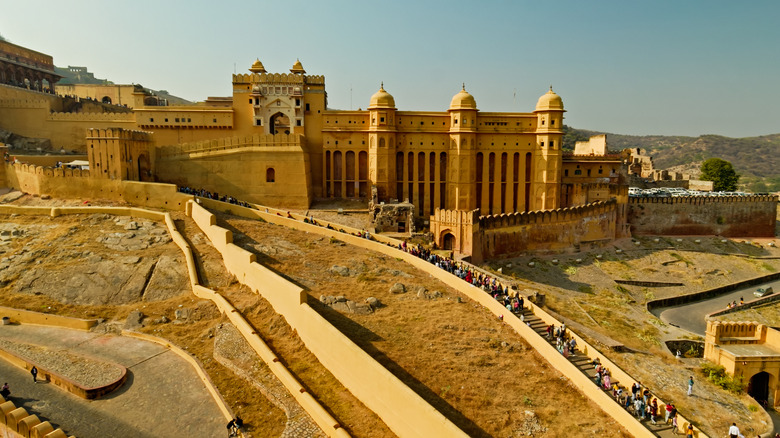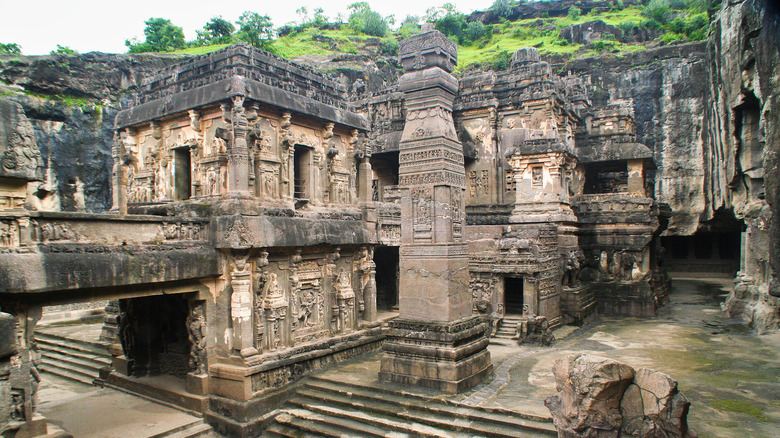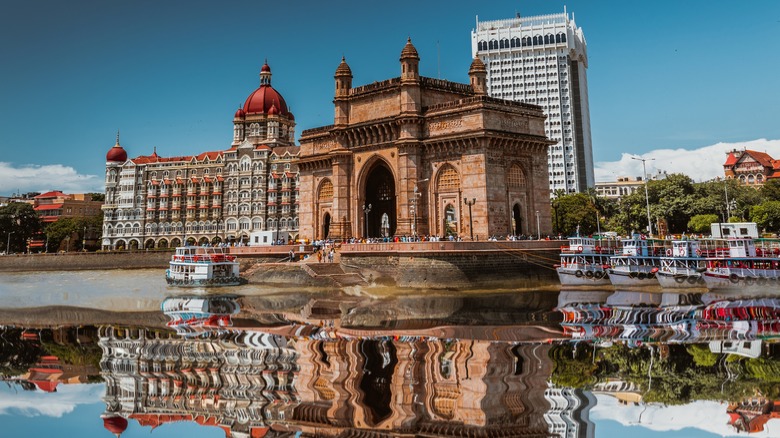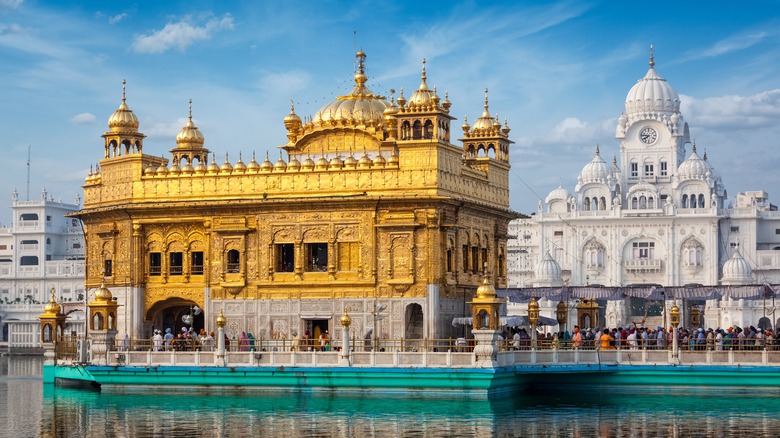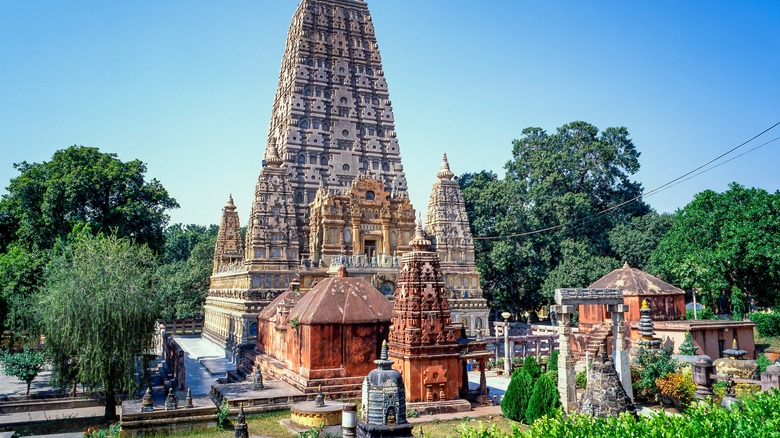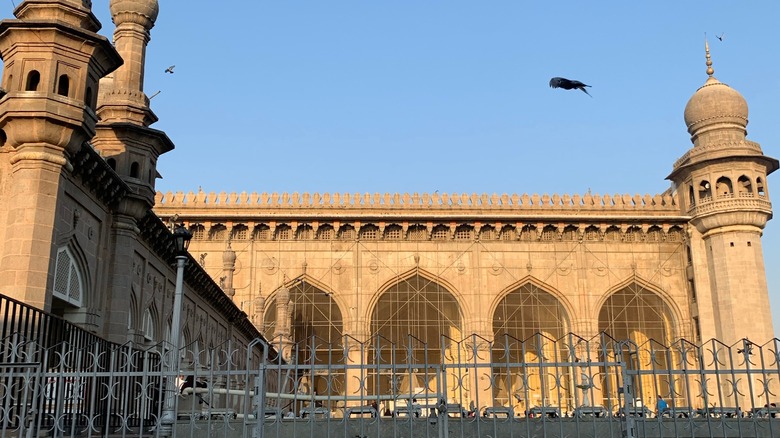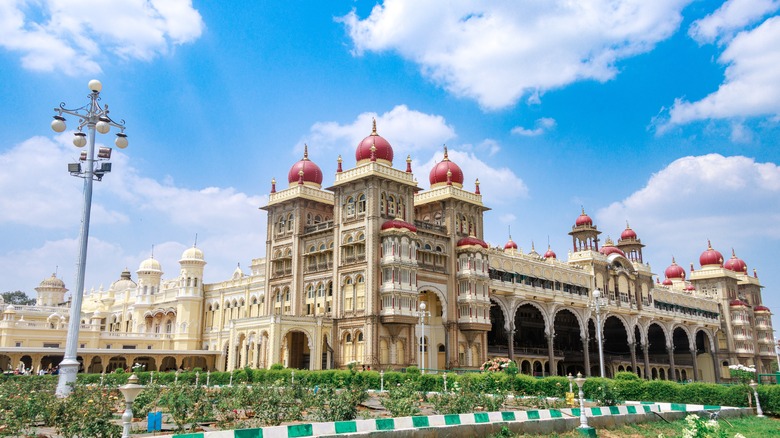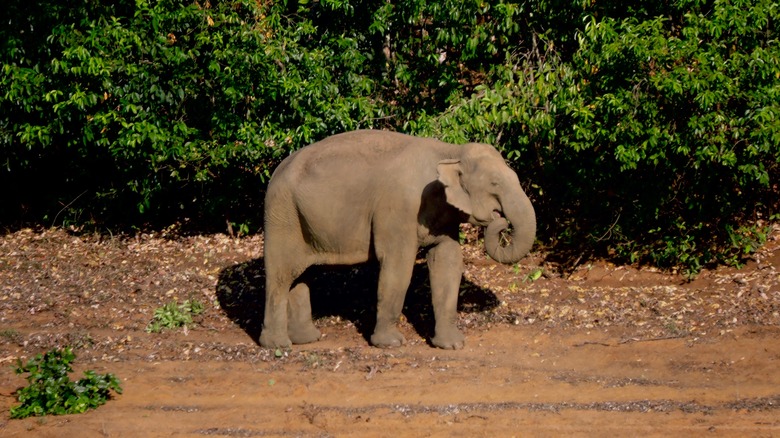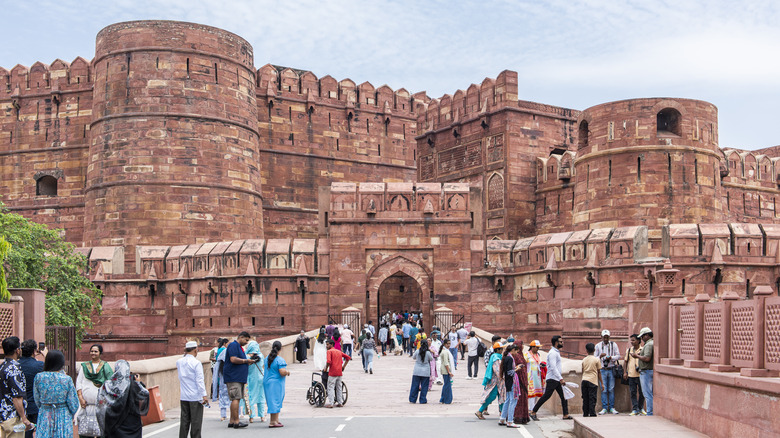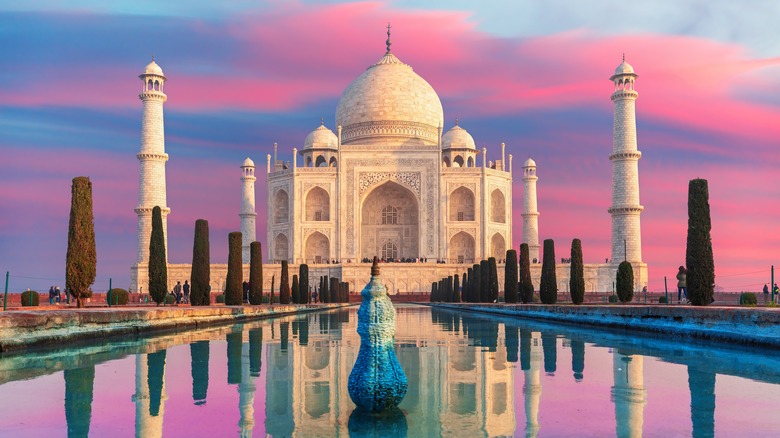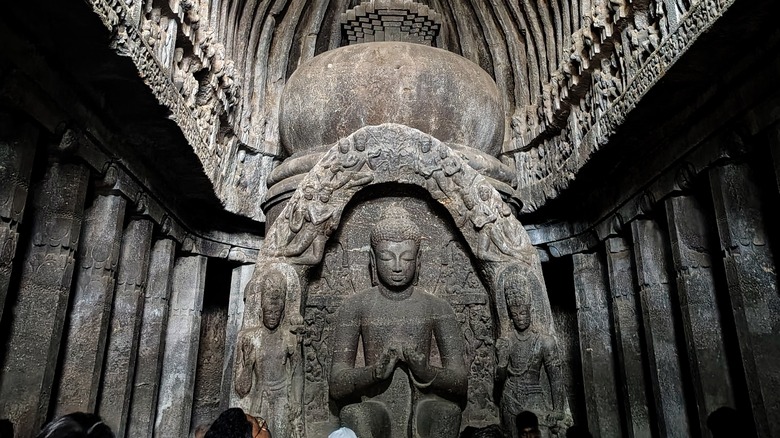India's 11 Major Tourist Attractions Every Visitor Should Explore
With the second-largest population on the planet and a history that spans thousands of years, there's so much to see — historically, culturally, and architecturally — in India, that planning a trip here feels more like solving a puzzle. How much time should you carve out to see the elegant white marble Taj Mahal, which attracts 8 million people annually? Which of the many astounding religious sites should you trek to here — maybe the aptly-nicknamed Gold Temple, or one of the largest mosques in the country? And which national park should you visit to see endangered species you've only ever seen in zoos?
PlanetWare solved this travelers' conundrum for you by determining which of the many tourist sites in India you need to explore, ranging from where Buddha found enlightenment to one of the largest cave temple complexes in the world. To do so, we evaluated which sites are the most well-known, which are the most popular, and which have the best and most reviews on TripAdvisor. That way, you won't have to wonder if that excursion is really worth the trek off the beaten path. In the meantime, though, get your Notes app out — because you're not going to want to miss these jaw-dropping sites on your trip to this amazing country.
Agra Fort, Agra
The Taj Mahal often gets all the attention in Agra, but just 1.5 miles away is one of the best Mughal forts in the country, making Agra a great addition to your history-buff bucket list. The Agra Fort, a UNESCO World Heritage Site located on the west bank of the Yamuna River, was once the home of the emperors of the Mughal Dynasty until the 17th century, when the capital became Delhi. An architectural marvel, it took 4,000 workers eight years to build using red sandstone reinforced with bricks. Another iconic feature is its foreboding moat, which surrounds the fort's 70-foot walls.
Inside, you'll find what can only be described as a city of its own — including Jahāngīr's Palace, the white marble Pearl Mosque, The Hall of Private Audience, the Octagonal Tower, and the Palace of Mirrors. Even more impressive, the Agra Fort isn't just a relic of India's past. Parts of it are still used as an Indian military fort, while the rest of it can be explored by visitors.
Amber Fort, Amer
Blending with the rocky hillside that it sits upon, the Amber Fort lives up to its name. Its yellow-and-pink sandstone walls rise royally from the grounds, making it clear why this was the home of emperors for more than a century. Like the Agra Fort, the Amber Fort, too, is more like its own city due to its many interior structures. But to see them, visitors will have to work for it by hiking up the hillside. Avoid the elephant and camel rides, since it's a popular tourist activity you should never do on your trip to India.
The home of the Rajput Kachwaha Dynasty from the 11th century through 1727, the UNESCO World Heritage Site is a sight to behold. It features Diwan-e-Aam, a hall where the emperor met with his subjects; Sukh Niwas (or Sukh Mahal), a then-state-of-the-art palace that even had its own air conditioning system; and Sheesh Mahal, a palace with mirrors lining its walls and ceilings. Visitors can also visit Jai Mandir, which is where royalty resided at the fort. All of the structures at the Amber Fort also surround Jaleb Chowk, a beautiful public courtyard.
Underneath the fort is a network of underground tunnels, some which remain unexplored to this day, that were once used as part of an emergency escape plan for the royal family to get to the nearby Jaigarh Fort. Beyond that, watchtowers also surround the fort, another element used for their protection. As a pro tip, try to stay after the sun goes down so you can see the light show that brightens the fort every night.
Ellora Caves, Aurangabad
The Ellora Caves, located in Aurangabad, are a representation of how dedicated Hindu, Buddhist, and Jain people were to honoring their deities — and of how all three religions co-existed in one place. For 400 years, beginning in the sixth century, craftsmen and laborers carved out 100 cave temples from one massive basalt rock in the Charanandri Hills. Stretching for over a mile, the Ellora Caves are one of the biggest cave temple complexes on the planet, which earned them a well-deserved designation as a UNESCO World Heritage Site. Today, visitors can visit 34 of the caves, which were once used as temples, monasteries, and rest stops for traveling merchants and monks. They're adorned with inscriptions, carvings, and sculptures, ranging from extremely simple to the more ornate.
The most famous cave in the complex is the Kailasa Temple, inspired by Mount Kailash, which looks more like a building than a cave. The largest single monolithic excavation on Earth, it features an assembly hall, gateway, 16 pillars, detailed carvings, and a Nandi statue. Other must-see caves include the Vishvakarma Cave — which houses a prayer house and 15-foot Buddha statue — as well as Indra Sabha, the largest cave in the complex.
The Gateway of India, Mumbai
There's no warmer welcome to India than the towering Gateway of India — an 85-foot-tall arch that was constructed to welcome British monarchs King George V and Queen Mary in 1911, when they traveled to the region for the first time. Since it wasn't actually finished until 13 years later, a six-foot cardboard arch was used in its place during the actual celebration. However, today, the real arch is a symbol of Indian history that's visited by many of the six million annual tourists that flock to Mumbai.
Known as the "Taj Mahal of Mumbai," the Gateway of India is considered one of the city's most-visited sites, welcoming upward of 600 visitors at any given time. In addition to exploring the landmark, tourists also head here to hop aboard the Elephanta Island ferry or the Alibaug ferry, since the gate overlooks the Arabian Sea. Made in both Indian and British architectural styles, the arch — built with concrete and yellow basalt stone — features a 50-foot dome with four turrets. Even more notable, the structure cost the Indian government 2.1 million rupees (roughly $25,000) to build back then.
In the years after its unveiling, the Gateway of India remained a royal site. It's even where British troops left the country for good in 1948 to mark India's independence. These days, it's joined by a statue of Maratha king Shivaji. On holidays like Independence Day and Republic Day, it's lit up in saffron, white, green, and navy. You can also see stunning views of the arch from the iconic Taj Mahal Palace, considered one of the most beautiful hotels around the world.
Harmandir Sahib, Amritsar
Bathed in gold leaf, gilded copper panels, stunning stones, and frescoes, Harmandir Sahib — otherwise known as the Gold Temple — looks like a building fit for royalty. However, it's actually the opposite. The most significant Sikh site is actually for worshippers of all castes, races, and faiths. It's even constructed a level lower than the ground, so visitors all need to (literally and figuratively) take a step down to go inside. The only requirements to enter the temple are that visitors cover their head, remove their shoes, and wash their hands and feet. Once you step inside, you'll hear the gurus sing as they do every day and night until the revered book, Adi Granth, is brought back to its resting place at the end of the evening.
Located in Amritsar, the original structure dates back to 1604, when it was built by the fifth Sikh guru Arjan. Although its current state dates back to 1776, it was damaged twice: Once by Afghan assailants decades after construction, and again 1982 during Operation Blue Star, a military operation by the government to eliminate Sikh separatists.
Designed in both Hindu and Islamic styles, the complex includes the namesake central temple within the Pool of Nectar, the Sikh headquarters in Punjab, a clock tower, an assembly hall, a memorial to the people killed there, and a dining hall. In line with the temple's philosophy to welcome all, the dining hall provides meals to thousands of people every day.
Mahabodhi Temple, Bodhgaya
There isn't a more sacred place for Buddhists to visit than the Mahabodhi Temple in Bodhgaya. After all, it's where Siddhartha Gautama, commonly known as "the Buddha," found enlightenment and formed his philosophy under the Bodhi Tree on December 8. After the revered event occurred, the 164-foot-tall Mahabodhi Temple was built during the third century by King Asoka The Great. The temple, also known as Bodhgaya Temple, as well as the Great Stupa, needed to be rebuilt between the fifth and sixth centuries, as well as renovated during the late 1800s.
Accompanied by a gold image of Buddha, it has since become one of the most-visited sites in Bodhgaya. It's also a UNESCO World Heritage Site, in addition to being a Buddhist Holy Place under the Bodhgaya Act. Moreover, the Mahabodhi Temple is also an architecturally significant one, as it's the only surviving shrine of its style to still stand after there once 84,000 in total.
A black stone temple adorned in gold, visitors will see and hear people chanting at 5:30 a.m. and 6 p.m., as well as others gathered outside meditating. There are also lots of other sites to see in the complex. These include the Bodhi Tree, marked by its heart-shaped leaves, as well as a pond that Buddha used to bathe in. Once you've checked out the structure, head to the complex's serene meditation garden to do as he once did.
Mecca Masjid, Hyderabad
With a massive prayer hall that stretches 225 by 180 feet — and featuring 75-foot ceilings as well as 15 ornate arches — there are no larger mosques in India than Mecca Masjid. With enough room to accommodate 10,000 worshippers within its massive space, the mosque is the legacy of Muhammad Quli Qutb Shah, who laid the first stones himself when construction began in 1617. From there, 8,000 workers followed suit. More than 75 years later, the mosque was finally finished after running into delays due to Quli Qutub Shah's death. The complex was completed under the watch of Mughal Emperor Aurangzeb, and the Indo-Islamic-style structure soon became one of the most renowned architectural projects of the Qutb Shahis.
Completely made of dressed stone from the city of Mecca (hence the mosque's name), it boasts five arches, two minarets with domes and balconies, and is also the final resting place of many of the Asaf Jahi rulers and their families. Additionally, Mecca Masjid also houses a courtyard with a hammam (Turkish bath), a sundial, and a room lined with Quran inscriptions that's home to age-old artifacts. Unfortunately, only male Muslims are able to see the glory of the mosque's prayer hall, and all must be dressed modestly. Nonetheless, the free-entry structure is open from 4 a.m. to 9:30 p.m.
Mysore Palace, Mysore
Move over, Taj Mahal. The Mysore Palace is another glamorous palace in India — as well as one of the country's largest, attracting 3.5 million visitors every year. With its ornate stone and marble domes, including a series of pink marble domes, the palace where the Mysore royal family resides is said to be just as beautiful as Buckingham Palace. It's even more beautiful on Sundays, holidays, and around the time of the 10-day Dasara Festival, when thousands of bulbs light the palace up for two months.
Throughout the centuries, the Mysore Palace underwent multiple reconstructions. In the late 16th century, a wooden palace that stood in its place was destroyed by lightning. Multiple subsequent versions were also either damaged or deliberately destroyed, with the current palace being commissioned by Maharaja Krishnaraja Wadiyar IV in 1912.
Blending Hindu, Islamic, Rajput, and Gothic architectural styles, the three-story palace features several must-see spaces. Marble floors, opulent corridors, and Hindu paintings fill the Public Durbar Hall, where the royal family once held ceremonial gatherings. Meanwhile, the Private Durbar is where the family used to hold private meetings surrounded by carved rosewood entrances, stained glass ceilings, and mosaic floors. Even better, visitors can also see where royal weddings were held in the Kalyana Mantapa.
Periyar, Madura
Besides its historic structures and rich culture, India is also known for its wildlife — including Indian elephants, Bengal tigers, and leopards. And there's no better place in India to see all of these creatures than Periyar, a nearly 575-square-mile preserve that's home to the Periyar National Park, Periyar Tiger Reserve, and Periyar Wildlife Sanctuary.
The 300-square-mile tiger reserve has many accolades, and is considered the best-managed tiger reserve in the country, as well as the oldest and the biggest. Better yet, it's also recognized by UNESCO as part of the country's Western Ghats. The space includes dense evergreen forests, the manmade Periyar Lake, and the Pamba River, and is home to 40 tigers, wild pigs, flying squirrels, sloths, mongoose, and lion-tailed macaques. In fact, a total of 35 types of mammals and more than 265 types of birds live here. Visitors can see these animals by hopping aboard a boat safari, or taking part in a guided jungle hike. Some can even stay overnight in a watch tower or forest home.
Prior to being a wildlife sanctuary, Periyar was a natural respite where the Travancore kings hunted for prey. However, in 1934, the space was deemed a reserve in order to stop tea plantations from building in the area. Those efforts become imperative later, when India sought to protect Bengal tigers — the national animal of the country — as well as Asian elephants. For even more insights into the country's biodiversity, a visit to Jim Corbett National Park (located all the way in the north) is another great destination for one-of-a-kind wildlife views.
The Red Fort, New Delhi
Named for its red sandstone construction, the 255-acre Red Fort is one of the most famous Mughal forts in the country. Located in the heart of what's now New Delhi since the 17th century, it was built by same architect who designed the Taj Mahal. The structure is so iconic that its Lahore Gate is considered the unofficial mascot of the city, and its image also appears on Indian currency. Today, bullet holes shot by the British can still be seen on it — marking one of the many times the fort was captured throughout history. To learn about British rule in India, visitors can also check out the fort's museums in the Kranti Mandir line of former barracks.
Besides seeing the Lahore Gate, visitors to the Red Fort should also check out the Diwan-i-Am, otherwise known as the Hall of Public Audiences. In this Mughal-style structure that features red sandstone columns, the emperor once sat upon his marble throne as he faced his subjects. Located behind the hall, the Khas Mahal, a white marble structure that served as the emperor's residence, features an octagonal tower where he loomed above the public.
The Taj Mahal, Agra
India's most famed architectural marvel is undoubtedly the Taj Mahal, a white palace completely constructed with marble on the banks of River Yamuna, in Agra. It was commissioned in grief and promise by Mughal emperor Shah Jahan, who had promised to build the tomb for his third wife Mumtaz Mahal, a Muslim Persian princess, after she died in 1631. Today, she is laid to rest, surrounded by jewels, within the structure's colossal dome. A UNESCO World Heritage Site, it took roughly eight years and 20,000 people to make the mausoleum alone. Once Shah Jahan died 35 years after his beloved wife, he too was buried in the building.
Although you can't see the royal couple's sacred tombs, you can take in the Taj Mahal's many stunning sights. This includes visiting a faux tomb with its own marble details and gems. The building is entirely surrounded by a walled Mughal garden filled with fruit trees and colorful flowers, a perfect place to take it all in. For history buffs curious to learn more about the Taj Mahal, there's also an onsite Taj Museum. That said, it's also worth reading up on these 13 things to know before visiting the Taj Mahal so you can make the most of your time there.
Methodology
In a country as big as India — it's one-third the size of the United States — you won't have an issue finding enough to do to keep yourself busy and your jaw dropping. Instead, the issue you'll likely face is whittling down that massive itinerary so you actually have time to explore the local culture and immerse yourself in different experiences — including the opportunity to learn more about India's unique dining etiquette while you indulge in its delicious and varied cuisine.
Thankfully, PlanetWare wanted to make sure you had enough time to see, do, and sleep during your trip, so we rounded up the 11 best tourist attractions that every visitor needs to explore. To do so, we first took to sites such as TripAdvisor and Google to determine which places had the most and best reviews from previous travelers. Then, we narrowed it down to which places were the most talked about — whether you live in America or Argentina — so you can rest assured that you're actually visiting the most iconic spots in India during your trip. Finally, we evaluated which places were the most popular by number of visitors, ranging from Mysore Palace (3.5 million annual visitors) to the Gateway of India (6 million visitors per year).


